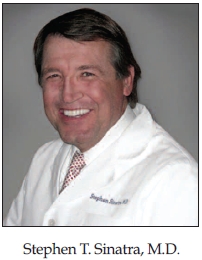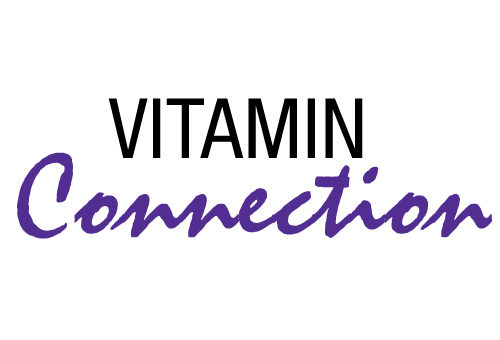We had just finished chatting with Stephen T. Sinatra, M.D., in our April column when a startling pronouncement was widely circulated in the media falsely claiming that L-carnitine, one of Dr. Sinatra’s pillars of heart health, was linked to heart disease. This theoretical “thinking out loud” report needs to be corrected, so we turn right back to Dr. Sinatra for clarification.
Dr. Sinatra needs no introduction to our long-time readers, as he has educated and informed us for many years. In 2004 alone, we discussed new developments in heart nutrition through six installments. We have discussed heart nutrition and health starting with the “Twin Pillars” to the “Awesome Foursome.” We have chatted about the real risk factors for heart disease and how to reverse heart disease with metabolic cardiology.
New readers may want to know that Dr. Sinatra is a board-certified cardiologist, certified bioenergetic psychotherapist, and certified nutrition and anti-aging specialist. He is a fellow in the American College of Cardiology and the American College of Nutrition as well as having served two four-year terms as the chief of cardiology at Manchester Memorial Hospital, where he had previously been director of medical education for 18 years.
Dr. Sinatra has written many books including Lower Your Blood Pressure in Eight Weeks (2003), The Sinatra Solution: Metabolic Cardiology (2005, 2008, 2011) and Reverse Heart Disease Now (2007). His latest books include, The Healing Kitchen (2010), Earthing: The Most Important Health Discovery Ever? (2010) and The Great Cholesterol Myth (2012).
Dr. Sinatra’s research and clinical experience has led to a better understanding of heart health, which is now embraced as “Metabolic Cardiology.” Previously, cardiologists essentially concentrated on oxygen supply in the heart, while metabolic cardiology goes further and considers energy supply in the form of available adenosine triphosphate (ATP) as well. Cells have components called mitochondria that produce ATP from food components and oxygen. Oxygen is important because it is needed to produce the energy compound ATP that makes the cells and heart work. Blood flow is important because it carries oxygen to the heart tissues. However, it is really the ATP levels in the heart and arteries that are the critical issues, moreso than oxygen levels. Shortly, I’ll ask Dr. Sinatra to explain why carnitines including L-carnitine and propionyl-L-carnitine (PLC) are so important to the heart’s production of ATP, but let’s start at the beginning of the story.
Passwater: Dr. Sinatra, one of your first two pillars of heart health—your famous Twin Pillars—is L-carnitine. You have discussed this with us in April 2004, telling us how you found that about 15% of people to whom you gave coenzyme Q-10 were refractory to it, and when you added the L-carnitine you got greater response. Please take our readers through the relationship here.
Sinatra: After the Ancona, Italy, coenzyme Q10 (CoQ10) meeting in 1996, I started to use high-dose CoQ10. At that meeting, I presented some refractory cases of heart failure patients who improved on 300 mg or more of CoQ10. We started to use a higher dose of CoQ10 after I presented those three cases. I would use 500, 600 or 700 mg in some patients and would draw blood levels. Occasionally, I would get blood levels of 3.5 micrograms (mcg) of CoQ10 per milliliter of blood and the patient wasn’t getting better.
I asked myself if there was anything else I could do for mito chondria support to make more of the energy-storage compound ATP. Sure enough, there was L-carnitine. As you know, CoQ10 ignites the spark that generates ATP, but L-carnitine is like the freight train shuttling in the fatty acids that are burned as fuel. What a lot of people don’t understand, including researchers and cardiologists, is that more than 60% of the heart’s energy is generated from the burning of fat, not carbohydrates. The brain requires carbohydrates. To summarize, because of their complementary actions, both CoQ10 and L-carnitine increase the turnover of ATP in mitochondria.
Passwater: Would you mind covering the basics of L-carnitine for our readers?
Sinatra: Well, L-carnitine is often classified as an amino acid, but it isn’t. L-carnitine can be thought of as a close cousin of amino acids, but technically it is a nitrogen-containing, short-chain carboxylic acid. It can also be described as a quaternary amine. Its chemical structure resembles choline. L-carnitine is not used as a building block by the body to form proteins. L-carnitine is a vital compound, but it is not classified as a vitamin as the body can usually make enough, starting with the amino acid lysine as its precursor.
However, L-carnitine’s synthesis is complex, involving five  different steps and with the first step having to be repeated three times. As we age, we are less efficient at producing L-carnitine just as we are less efficient at producing CoQ10. As many people shun red meats and especially lamb (which may be the best food-source for L-carnitine), their blood levels can become too low in L-carnitine.
different steps and with the first step having to be repeated three times. As we age, we are less efficient at producing L-carnitine just as we are less efficient at producing CoQ10. As many people shun red meats and especially lamb (which may be the best food-source for L-carnitine), their blood levels can become too low in L-carnitine.
A major role of L-carnitine is to transport long-chain fatty acids into the inner membrane of mitochondria. Remember, the heart needs a lot of energy and the best source of energy-producing fuel in the body is fat. A gram of fat supplies nine calories whereas a gram of carbohydrate supplies only four calories. The heart uses free fatty acids as its main energy source, and the only way for long-chain fatty acids to get to the inner membrane of the mitochondria where energy is produced in the respiratory chain is for L-carnitine to carry them there.
Inside the mitochondria, fatty acids are oxidized by oxygen. It is a “slow burn” that releases electrons that pass along complexes in what is called the respiratory chain to eventually produce ATP. The ATP is ultimately transported to various parts of the cell to supply energy when needed. It is the generation of this energy that supplies the vital force so necessary for life. Enzymes use ATP as the chemical energy to initiate reactions. Enzymes can make chemical reactions go at rates more than a billion times faster, but they need energy to do this. This whole process of energy formation and transfer is called respiration. The final products that are generated by fatty acid oxidation are water and carbon dioxide.
Passwater: Let me review this, since it is such an important point. Without carnitine, fats, which are the high-energy fuel for the heart, muscles and certain other body components including the endothelial cells of artery linings, cannot be converted into ATP. ATP is the energy of life. “Life” depends on the body utilizing energy. In the “living” process, “free energy” is released from the stored energy in ATP. Energy is a force, not a compound. The principal source of “free energy” in the body is in the high-energy bond phosphate group (P).
For the biochemical reactions of life to occur, “free energy” must be liberated through a chemical reaction in which ATP is split into adenosine diphosphate (ADP) and the high-energy bond phosphate (P) group (the source of free energy).
Sinatra: Nature created carnitine to serve as a freight train or ferry boat to carry those fatty acids into the mitochondria. More importantly, it’s not only the burning of fat in the mitochondria that fuels the energy for ATP, but also the fact that the human being is a high-energy organism. Because we are so high-energy, we produce a lot of toxic waste. This is where the carnitines are so absolutely phenomenal and instrumental—especially in cardiac health. Not only do these carnitines shuttle in the fatty acids to be burned in the mitochondria, but they also shuttle out the toxic metabolites.
 That’s why the carnitines—especially the heart-specific propionyl-L-carnitine (PLC) you mentioned earlier—are important. In my practice, for instance, I used the carnitines for intermittent claudication and their claudication improved remarkably, again, not because the fat is burned easier, but because the toxic byproducts of energy production such as acyl groups are removed more quickly. These harmful acyl groups—metabolites of the burning of fat, and even lactic acid for that matter—cause vasoconstriction. They are unfriendly to endothelial cells (i.e., flat epithelial cells that line serous cavities, lymph vessels and blood vessels) and they cause spasms of the blood vessels. You can imagine if you have patients with a lack of oxygen in the lower extremities caused by ischemia (i.e., reduced blood flow) in the leg muscles. Toxic metabolites build up and you have to get them out of the cell.
That’s why the carnitines—especially the heart-specific propionyl-L-carnitine (PLC) you mentioned earlier—are important. In my practice, for instance, I used the carnitines for intermittent claudication and their claudication improved remarkably, again, not because the fat is burned easier, but because the toxic byproducts of energy production such as acyl groups are removed more quickly. These harmful acyl groups—metabolites of the burning of fat, and even lactic acid for that matter—cause vasoconstriction. They are unfriendly to endothelial cells (i.e., flat epithelial cells that line serous cavities, lymph vessels and blood vessels) and they cause spasms of the blood vessels. You can imagine if you have patients with a lack of oxygen in the lower extremities caused by ischemia (i.e., reduced blood flow) in the leg muscles. Toxic metabolites build up and you have to get them out of the cell.
That’s the magic of the carnitines. Carnitines were created by the body for a reason: to get fats in and toxins out.
Passwater: While we’re covering the Twin Pillars, we might as well discuss the recent study by Svend Mortensen, M.D., Ph.D., of the Heart Centre of the Copenhagen University Hospital, which showed that CoQ10 (in the ubiquinone form) can reduce heart failure by half (1). This correlates well with Dr. William Judy’s 1990–2010 study, which found that Class IV Congestive Heart Failure (CHF) patients had 48% less mortality in three years when treated with CoQ10 plus conventional therapy than CHF patients treated with conventional therapy and placebo. (See “The Coenzyme Q-10 Breakthrough,” WholeFoods Magazine, January 2002.)
Sinatra: Dr. Mortensen reported the results of the Q-SYMBIO study of patients having moderate to severe congestive heart failure living in eight countries in Europe and Asia. It was a two-year, placebo-controlled, double-blind clinical trial. The study group took 100 mg of CoQ10 (as ubiquinone) three times daily. A quarter of the placebo group patients suffered a major adverse cardiovascular event, whereas only 14% of the study group did. In addition, CoQ10 reduced the level of a biomarker of heart failure, NT-proBNP.
Passwater: Okay, let’s get back to L-carnitine. I’m sure you read the Mayo Clinic review of 13 clinical studies published online on April 13 showing that L-carnitine had multiple heart benefits (2).
Doesn’t this study confirm your earlier teachings?
Sinatra: Yes. The Mayo Clinic reviewed 13 clinical trials involving 3,629 patients who previously had a heart attack (myocardial infarctions) and found that L-carnitine had several heart health benefits. They concluded that L-carnitine reduced all-cause deaths in this large heart patient group by 27%, reduced angina symptoms by 40% and reduced ventricle arrhythmias by 65%.
The article attributed survival benefits to the ability of L-carnitine to limit infarct size, stabilize heart cell membranes and improve compromised cellular energy metabolism. This study made good sense to me. It confirmed my own clinical findings and reminded me of an Italian study I reported on in 2007, which showed that centenarians who supplemented with L-carnitine had significant improvements in energy, muscle mass and mental function—plus, less fatigue and fat mass. It’s also important to remember that, like CoQ10, your body manufactures L-carnitine—and the reason it does is because it’s essential to good health.
Multiple animal studies demonstrate the beneficial effects of supplemental L-carnitine in cardiovascular prevention. In addition, multiple human studies confirm the benefits of L-carnitine in documented heart disease (i.e., heart attack, angina, congestive heart failure and atherosclerotic vessels).
Passwater: Unfortunately, the report that received so much media attention was not the Mayo Clinic report, but the preliminary, largely theoretical study of only 10 people by Koeth et al. Published online on April 7, it incorrectly warned that L-carnitine was linked to heart disease (3). As a result of that report, many people stopped taking the L-carnitine they were using for heart health and to lower their risk of diabetes. What was that all about anyway?
Sinatra: The Koeth et al. publication said the culprit linking red meat with heart disease was not saturated fat but trimethylamine N-oxide (TMAO), a waste product produced by certain intestinal bacteria as a result of exposure to L-carnitine and a long-term diet high in red meat. They are correct in saying that saturated fat is not the culprit (4), but the rest is wild, poorly substantiated conjecture at best. I’m trying to be polite here.
I also don’t understand why this publication presenting such “blockbuster research” was not printed in a major cardiovascular journal. So many well-designed and replicated studies have confirmed the efficacy and safety of L-carnitine for human consumption. In my own clinical experience using carnitine for almost two decades, it has been absolutely life saving in critically ill and vulnerable patients. The Koeth et al. publication examined a group of mice that are bred to spontaneously develop heart disease and they did feed them L-carnitine, but mice normally encounter no carnitine in their diets as they are plant eaters and not flesh eaters. L-carnitine is found only in animals. Plant-eating rodents eating L-carnitine may metabolize L-carnitine differently than humans.
It is interesting to note that a couple of the researchers have applied for a patent for “Trimethylamine-containing compounds for diagnosis and prediction of disease.”
Passwater: What other health benefits does L-carnitine offer?
Sinatra: Carnitine has been instrumental in helping male patients with fertility issues and has offered tremendous benefit in patients with kidney disease, lipid disorders, and in those taking statin drugs. The overzealous use of statins has created multiple situations of muscle weakness—some of them having to do with hidden carnitine enzyme deficiencies. I also like carnitine for anyone who drinks alcohol as it has supportive metabolic interactions for the liver.
Passwater: How about benefits for athletes?
Sinatra: As I mentioned in our chat back in March 2006, I think every athlete should be using carnitine, CoQ10 and D-Ribose. It just makes perfect sense. By the way, we have recently published new data on CoQ10, carnitine, ribose, boswellin and curcumin in a special athlete: the Thoroughbred Racehorse. We have shown this combination of nutraceuticals not only improves recovery, but it also reduces inflammation due to moderate exercise.
The inflammatory response to vigorous exercise ranges from the mild symptoms of delayed-onset muscle soreness to debilitating injuries affecting soft tissue, joint and bone. Increased attention is being focused on the role of inflammatory mediators in lameness. We are also investigating if CoQ10 can prevent exercise-induced pulmonary hemorrhage (EIPH), which continues to be a major problem in the thoroughbred industry (5).
Passwater: Would you recommend that healthy people and athletes take L-carnitine? If so, how much?
Sinatra: Since carnitine is not plentiful in the diet unless you’re eating lamb and beef frequently, it should be taken as a supplement. I recommend 200–600 mg per day for healthy people and up to 3,000 mg per day for athletes. In my book Metabolic  Cardiology, I have a program for world-class athletes using a metabolic approach to support the free radical surge that occurs with intensive exercise.
Cardiology, I have a program for world-class athletes using a metabolic approach to support the free radical surge that occurs with intensive exercise.
Passwater: Dr. Sinatra, once again our readers thank you for discussing heart health and L-carnitine with us. Readers can find more at www.drsinatra.com. WF
Dr. Richard Passwater is the author of more than 45 books and 500 articles on nutrition. Dr. Passwater has been WholeFoods Magazine’s science editor and author of this column since 1984. More information is available on his Web site, www.drpasswater.com.
References
1. S.A. Mortensen, et al., “The Effect of Coenzyme Q10 on Morbidity and Mortality in Chronic Heart Failure. Results from the Q-SYMBIO Study,” Abstract 440. Heart Failure Association of the European Society of cardiology.
2. J.D. DiNicolantonio, et al., “L-Carnitine in the Secondary Prevention of Cardiovascular Disease: Systematic Review and Meta-Analysis,” Mayo Clinic Proceed. 88 (6), 544–551 (2013).
3. R.A. Koeth, et al., “Intestinal Microbiota Metabolism of L-Carnitine, a Nutrient in Red Meat, Promotes Atheroscleroisis,” Nature Med. 19, 576–585 (2013) doi:10.1038/nm.3145, Published online April 7, 2013.
4. J. Bowden and S. Sinatra, The Great Cholesterol Myth (Fair Winds Press, Minneapolis, MN, 2012).
5. S.T. Sinatra, et al., “Coenzyme Q10 in Equine Serum: Response to Supplementation,” J. Equine Veterin. Sci. 33, 71–73 (2013).
Published in WholeFoods Magazine, August 2013










